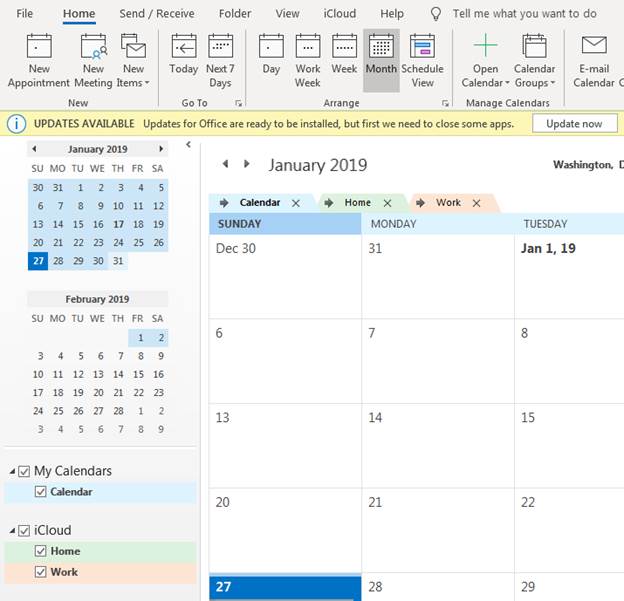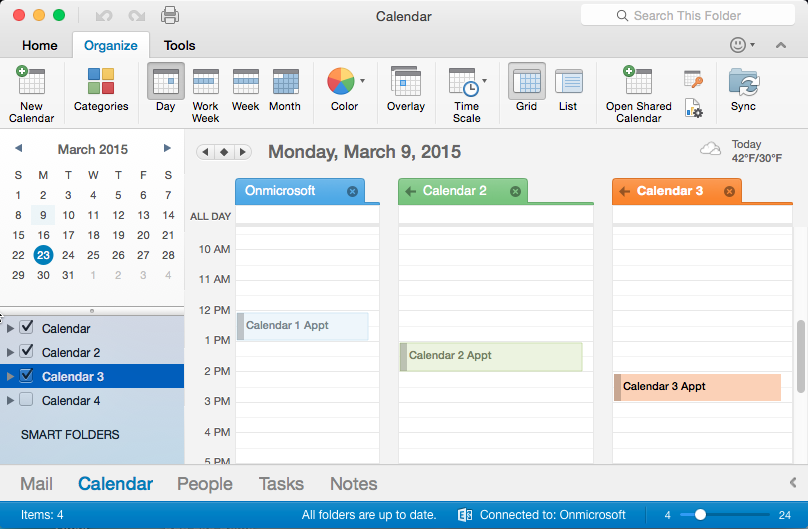

The MS Outlook Calendar settings are successfully reset. Under Advanced, click AutoArchive Settings.Įnsure that Run AutoArchive every is unchecked.Ĭlick the calendar tab on the bottom-left corner of the screen. Choose the appropriate key stroke combinations to reflect the number of days to view: a. The calendars can be a combination of your default calendar, calendars you've created, and calendars you've connected to. The custom calendar view can hide your meetings after setup. lets you view more than one calendar at a time. If meetings are not displaying on your calendar, they have been archived automatically.Ģ. Calendar events are not populating in the Outlook calendar due to incorrect auto-archive settings. My start time is 8am, but I want to see the hours from 6am - 8pm displayed. Users report that after receiving and accepting meeting requests, they do not see the meetings on their calendar.ġ. Microsoft Calendar view of time display defaults to 8am - 10pm.

#Outlook calendar view how to#
When a participant is on hold in a meeting, their info is still included for this period of time in the attendance report.This article provides information on how to reset the MS Outlook calendar view to fix visibility issues of meetings/events. If someone waits in the lobby and doesn't get admitted to the meeting, they won't be included in the report. You can go to the Attendance tab in the Teams calendar invite for all channel meeting attendance reports. If a channel meeting is in progress and someone starts a second meeting within the same channel conversation, an attendance report will be available only for the second meeting. The report does not currently include view-only attendees. The report does not include insights from deleted breakout rooms. Although Outlook does not include a yearly calendar, you can view a yearly calendar using the navigation calendars in Outlook or use VBA to create an HTML.

#Outlook calendar view full#
The post-meeting report will contain the full list. Open a calendar in side-by-side view In Calendar, in the Navigation Pane, select the check box of another calendar that you want to view. In meetings with more than 120 participants, the attendance report that's available during the meeting will only include a partial list of attendees. To view the attendance reports for meetings created in channels, click More actions > View meeting details, and navigate to the Attendance tab. Locate the section labeled My Calendars on the left side of the. Note: For recurring meetings, you'll receive a unique attendance report after each occurrence. Click the Calendar icon at the bottom of your Outlook screen to open the calendar view. You can also change your Outlook calendar’s font size and style, or choose a different background color. For example, you can quickly switch between day, week, or month views, or change your work week start day and time. You can view the data directly in Teams.įor recurring meetings, select the report you want to view from the dropdown list. Outlook lets you change your calendar view to suit your own situation and working style. In Teams, go to Calendar, open the meeting, and select the Attendance tab. You'll find the attendance report in a few different places. Look for the file in your device's Downloads folder.
#Outlook calendar view download#
Select More actions, then select Download attendance list to download the current attendance info as a CSV file that you can open in Excel. If the participants pane isn't open, select People in your meeting controls. Participants can decide whether they want their information shown in attendance reports by going to Settings > Privacy in Teams and turning the Identify me in attendance reports toggle on or off.įor more help managing your meeting attendance report settings, contact your IT admin. Turn the Allow attendance report toggle on or off. It doesn't have a picker surface and the calendar is always visible. A user can select a single date or a range of dates.

To turn attendance reports on or off before your meeting: A calendar view lets a user view and interact with a calendar that they can navigate by month, year, or decade.


 0 kommentar(er)
0 kommentar(er)
